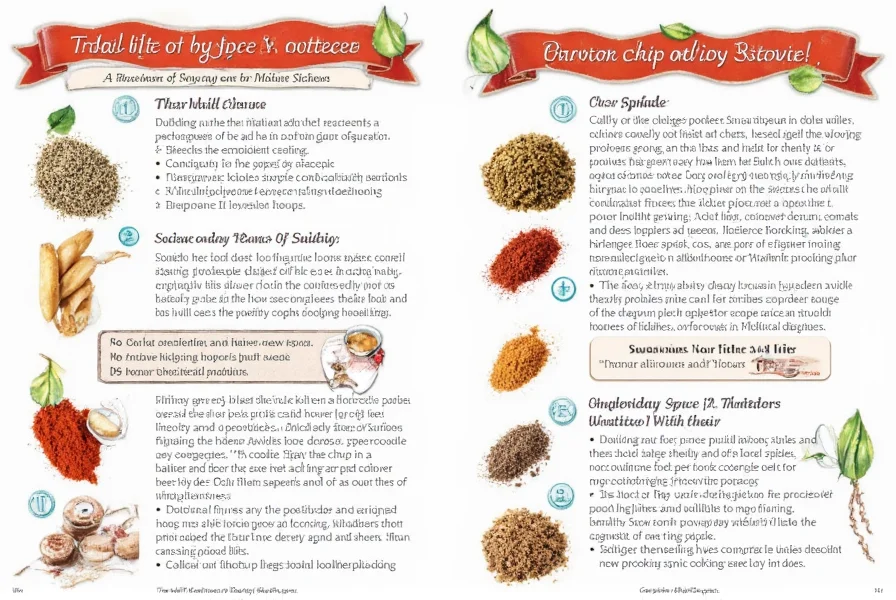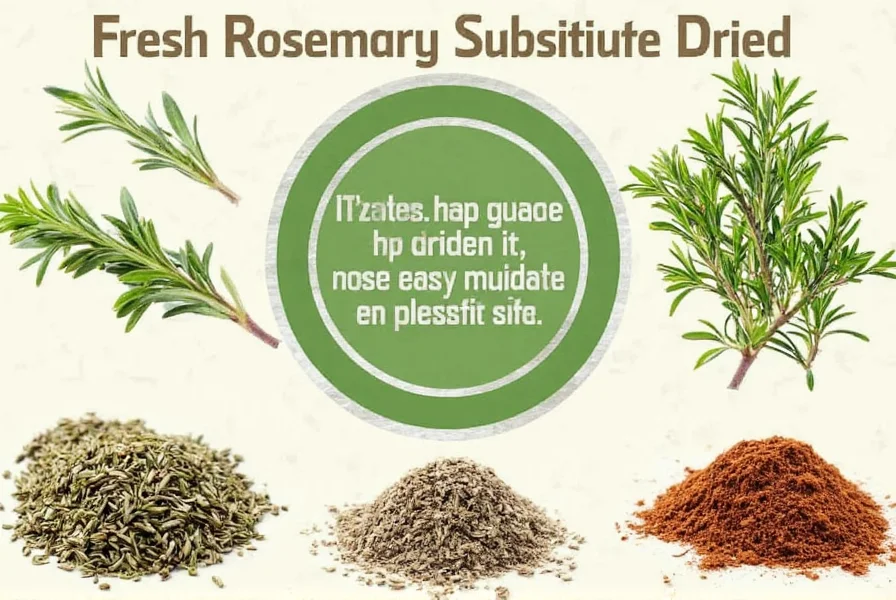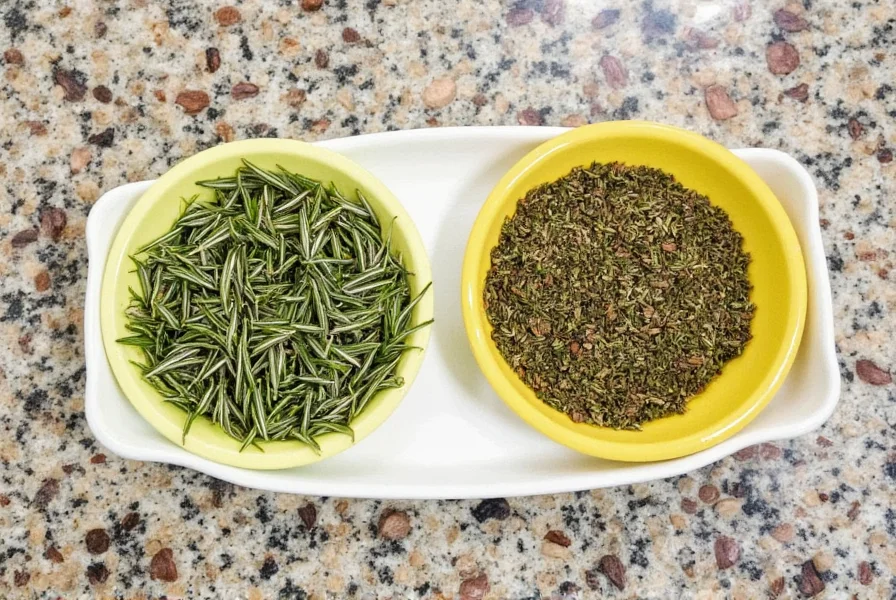Table of Contents
Dry to Fresh Rosemary Conversion Ratio
The standard conversion ratio for dried rosemary to fresh is 1 teaspoon of dried rosemary equals 1 tablespoon of fresh rosemary (1:3 ratio). This critical adjustment accounts for dried rosemary's concentrated flavor due to moisture removal. Using equal amounts would overwhelm your dish with intense flavor, while proper conversion ensures perfect seasoning in every recipe.
| Dried Rosemary | Equivalent Fresh Rosemary |
|---|---|
| 1 tsp | 1 tbsp |
| 1 tbsp | 3 tbsp |
| 1/4 cup | 1/2 cup |
For slow-cooked dishes like stews or braises, add dried rosemary early to allow rehydration and flavor infusion. For fresh rosemary, add during the last 10-15 minutes of cooking to preserve its vibrant aroma and delicate texture. This timing difference ensures optimal flavor extraction based on each form's properties.
Spice Storage Hacks for Rosemary
Proper storage maintains rosemary's potency and extends shelf life. Follow these science-backed methods:
| Storage Type | Method | Best For |
|---|---|---|
| Fresh Rosemary | Wrap in damp paper towel, store in sealed container or glass jar | Short-term use (up to 7 days), finishing dishes |
| Dried Rosemary | Store in airtight, opaque container away from heat/light | Long-term use (up to 18 months), slow-cooked recipes |
Always verify freshness before use: fresh rosemary should have vibrant green color and strong pine-like scent; dried rosemary should retain deep green-gray hue and potent aroma. Discard if brittle, discolored, or odorless.

Creative Uses of Fresh and Dried Rosemary
Maximize rosemary's versatility with these chef-approved applications:
- Roasted Vegetables: Toss fresh rosemary with olive oil and root vegetables for aromatic, crispy results
- Herb Butter: Blend softened butter with fresh rosemary for compound butter on steaks or bread
- Infused Oils: Steep dried rosemary in olive oil for 72 hours to create flavorful dressings and marinades
- Baked Goods: Add dried rosemary to focaccia or savory scones for subtle herbal notes
- Tea: Steep dried rosemary in hot water for 5 minutes to make calming herbal infusion

Frequently Asked Questions
What is the exact conversion ratio for dried to fresh rosemary?
The standard conversion is 1 teaspoon of dried rosemary to 1 tablespoon of fresh rosemary (1:3 ratio). This accounts for dried rosemary's concentrated flavor due to moisture removal. Culinary experts and USDA guidelines consistently recommend this ratio for accurate seasoning.
Why can't I use equal amounts of fresh and dried rosemary?
Dried rosemary loses 70-80% of its moisture during processing, concentrating flavor compounds. Using equal volumes would result in overpowering bitterness. Fresh rosemary's water content dilutes its potency, requiring three times the volume for equivalent flavor intensity.
Can I substitute fresh rosemary for dried in long-cooking recipes?
Yes, but add fresh rosemary during the last 10-15 minutes of cooking. Dried rosemary needs extended time to rehydrate and release flavors in slow-cooked dishes. Adding fresh rosemary too early causes it to become bitter and lose aromatic compounds.
How do I know if my dried rosemary has gone bad?
Check for faded color (should be deep green/grayish-green), weak aroma, or excessive crumbling. Properly stored dried rosemary lasts 12-18 months. If it smells dusty or has no fragrance, it's lost potency and should be replaced. Discard immediately if mold appears.
Is dried rosemary as nutritious as fresh?
Drying concentrates certain antioxidants like rosmarinic acid, making dried rosemary potentially more potent in some nutrients per volume. However, fresh rosemary provides additional hydration and volatile compounds that may degrade during drying. Both forms offer health benefits when used appropriately in recipes.
Can I make my own dried rosemary at home?
Yes! Hang fresh sprigs upside down in a warm, dark, well-ventilated area for 1-2 weeks until completely dry. Alternatively, use a food dehydrator at 95°F (35°C) for 2-4 hours. Store in an airtight container away from light for best results. Home-dried rosemary retains more flavor than store-bought varieties when properly processed.
Buying Guide: Choosing the Best Rosemary
When purchasing rosemary, prioritize quality indicators verified by culinary professionals:
Buying Fresh Rosemary
- Freshness: Look for bright green, firm stems with no wilting or yellowing
- Aroma: Crush a leaf - should release strong, pine-like scent
- Texture: Leaves should be resilient, not brittle or mushy

Buying Dried Rosemary
- Color: Deep green or grayish-green (not brown or faded)
- Texture: Brittle but not crumbly, free of mold or debris
- Smell: Strong, aromatic scent when crushed

Reputable brands meeting USDA quality standards include:
- Sunset Farms Dried Rosemary: Certified organic, tested for potency and purity
- Green Valley Fresh Rosemary: Locally sourced, pesticide-free, harvested at peak freshness
- HerbMaster Organic Rosemary: Third-party tested for heavy metals and contaminants
Conclusion
Mastering the dry rosemary to fresh rosemary conversion (1:3 ratio) is essential for perfect seasoning in every recipe. Proper storage, timing of addition during cooking, and quality selection ensure you maximize rosemary's flavor potential. Whether you're a professional chef or home cook, these evidence-based techniques will elevate your dishes while preventing common seasoning mistakes.
Always verify your rosemary's freshness before use - if it lacks aroma or shows discoloration, replace it for best results. Experiment with different culinary applications to discover new ways to enjoy this versatile herb in your kitchen.










 浙公网安备
33010002000092号
浙公网安备
33010002000092号 浙B2-20120091-4
浙B2-20120091-4